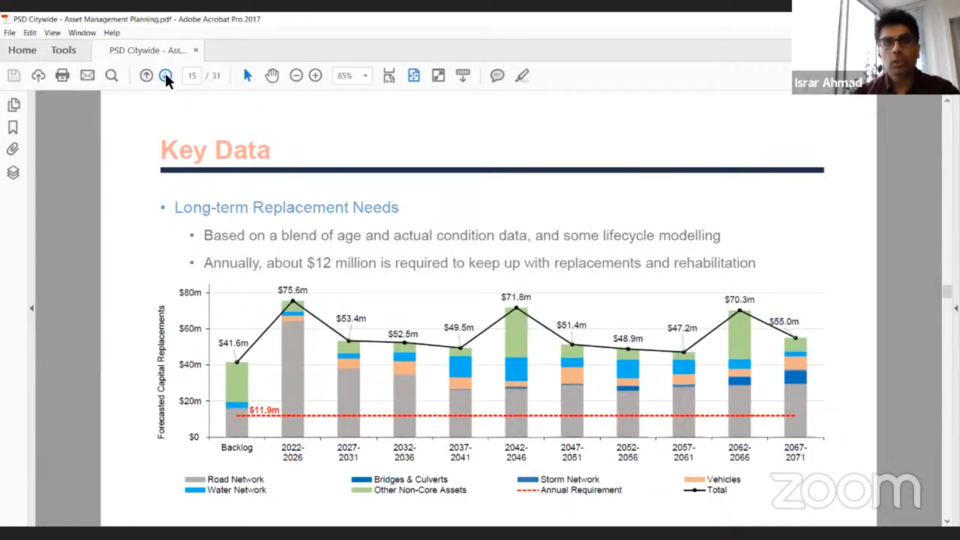Most times, it is better to face a problem head on than to let it grow at the wayside, but just try to watch a politician say that to a constituent.
Tiny council received a crash course in asset management during their recent 2023 draft budget discussions, thanks to a concentrated dose of information from a knowledgeable project manager.
Israr Ahmad, a PSD Citywide program manager for asset management advisory, boiled down a dense 92-page asset management plan (AMP) and strategy (AMS) into a digestible 30-slide presentation, receiving large thanks from council and staff who were deep into a long day on the municipality’s budget accountability.
By regulation, all municipalities in Ontario must complete an AMP and Ahmad praised Tiny for exceeding requirements by not only reporting the necessary 2022 core assets like road, water and sanitary networks, but also non-core assets such as buildings, vehicles and land improvements ahead of their need in the coming years.
“For us, the very basic data you need… for all assets,” said Ahmad, “things like quantity, replacement costs, the condition of the assets, its estimated design life, and a whole lot of other data that can support risk management.
“Any given asset in a municipality can have anywhere from 10 or 15 to 30 or 40 different data points, and each of these data points needs to be managed; often we’ll see that municipalities will have thousands and thousands of assets.”
In managing the complexity of assets, a municipality can confidently know how best to service their community through allocation of staff time, money and resources.
For Tiny Township, an estimated $320 million in core and non-core assets were tallied as the current replacement costs – the amount expected to replace the asset on its end of use – with the road network taking up 57% (or $183 million) as the majority. Most of the core infrastructure such as roads and bridges were estimated as fair or better at 77% of assets, while the remaining 23% were deemed poor or worse conditions.
As Ahmad explained, the quality of the data influenced how it was interpreted; if actual data couldn’t be collected such as for assets without historic data, then best guesses were made through predictive modeling and personal experience.
“Most municipalities do asset management by a system and move on,” said Ahmad, “but by doing a strategy you’re positioning yourself to meet long-term needs.”
The average annual requirements (AAR) to reinvest into assets for Tiny was stated at $11.9 million, with a caution that if less funding is put into that amount a shortfall of infrastructure deficit is created. On average for the previous three years, $3.7 million in funding (or 31% of $11.9 million) was made available through permanent and predictable streams like property tax, water rates, and upper-tier funding. Tiny’s reinvestment rate was calculated at 1.2%, which was less than the 3.7% comparison of other municipalities.
To compensate, PSD Citywide recommended Tiny look to implementing a 2.3% annual increase in revenues over a phase-in of 20 years with intent to generate revenue above the $3.7 million AAR; similarly, water rates would need to increase at 1.3% for full-funding over a phase-in of 10 years.
“It sounds scary, but we do have to temper these estimates with actual staff knowledge,” said Ahmad, reiterating that Tiny had an advantage over other municipalities through the AMS. The recommendation was in establishing an asset management culture in Tiny, to build data that would enhance understanding and service for improving their system over a two-year period.
A full-time asset management coordinator position was also recommended, with several on Tiny staff lamenting and praising the efforts made by those currently trying to fulfill the difficult role.
Mayor David Evans said that the information was a lot to consider.
“It goes back to the AMP and getting this message across to our constituents: $320 million of assets is a staggering amount of money,” said Evans. “I hate to say it from a politician’s perspective, it’s going to come down… in terms of projects, and what we’re going to choose to do (or not)… in any given year.”
Ahmad gave some sugar to the bitter pill through a reminder that a dynamic risk matrix would allow staff the leniency to reprioritize critical projects as needs arose.
“The hard conversations do need to be had with constituents,” Ahmad advised; he added that in community engagements with other municipalities, he was impressed with the technical understanding that residents brought.
At the end of the presentation, Evans thanked Ahmad; additional thanks were given to previous council terms for their work on the AMP.
“We’ll carry on the same tradition in making sure the township is safe and secure for the future.”
The next planning session for the draft 2023 budget will occur during the January 25 special committee of the whole.
The draft 2023 budget overview, including the detailed PSD Citywide asset management report and slideshow, can be found on the agenda through the township website.
Archives of council meetings are available to view on Tiny Township’s YouTube channel.
